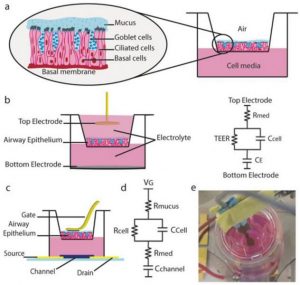E-cigarettes have become increasingly popular alternatives to smoking tobacco cigarettes. Currently, the health effects of “vaping”, or inhaling the aerosol generated by e-cigarettes, are largely unknown. Originally intended for use as a stop-smoking aid, their recreational use is growing. The vaping phenomenon has elicited some controversy by spawning nicotine addiction among nonsmokers, including youth and minors, who are more likely to find the assortment of candy-flavored pods available on the market appealing—not to mention the sleek e-cigarette designs, which make for fashionable accessories.
How e-cigarettes affect the tracheal epithelium, which acts as a barrier to prevent the entrance of harmful inhaled particles into the body, is not well known and has prompted the development of in vitro methods to analyze aerosol toxicity. Current commercial technologies are unable to provide an assessment of tracheal barrier integrity under physiological conditions.
University of Cambridge researcher Dr. Róisín M. Owens, Dr. Marc Ramuz of MINES St. Étienne, and co-workers have developed a sensing platform to measure tracheal barrier integrity at the air–liquid interface (ALI) after aerosol exposure from e-cigarettes.

Their device, which consists of an organic electrochemical resistor (OECT) combined with a conformal flexible gate (fg), enables continuous electrical measurement at the ALI and does not rely on liquids—a limitation of previous studies.
A human airway epithelium model was exposed to e-cigarette aerosols from an e-liquid mixture of propylene glycol, vegetable glycerin, and nicotine in concentrations corresponding to 25 and 30 puffs. Electrical measurements using the fg-OECT over four hours showed that the complete loss of epithelial barrier properties occurs within 3.5 hours of aerosol exposure.
Results suggest that the aerosol produced from e-cigarettes should be considered harmful, but a model that measures exposure over a longer period (i.e., several days or weeks) is needed to more thoroughly investigate the cytotoxic effects of e-cigarettes.
This technology could potentially be adapted to in vitro studies for other tissues with ALIs, including lungs and skin.
The featured photo: “Young man vaping and holding an e-cigarette” by Sarah Johnson, used under CC BY 2.0.

















